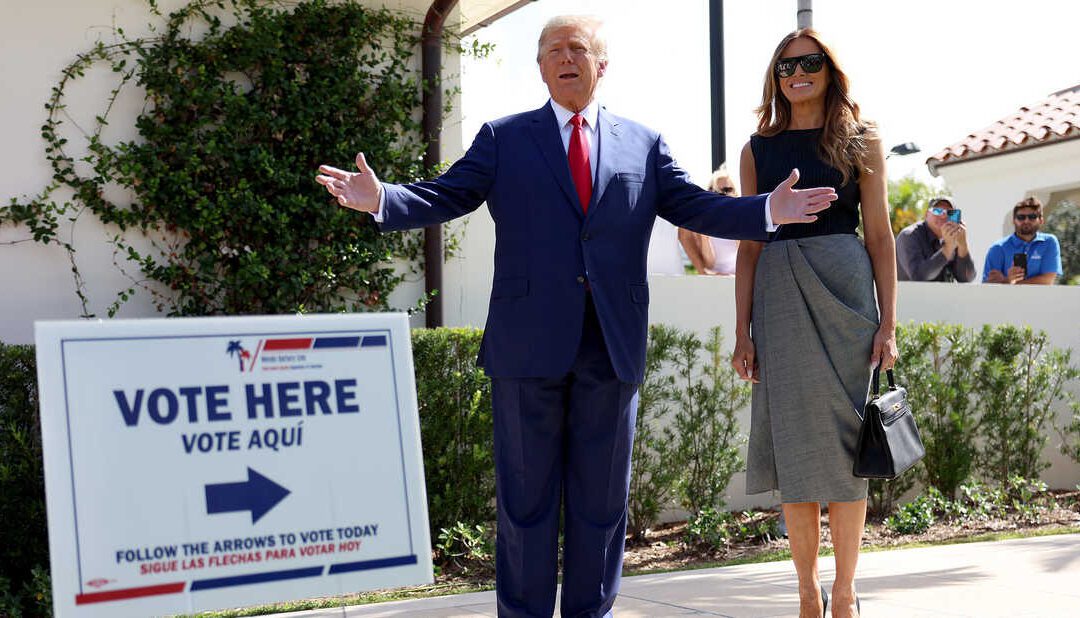
#image_title
Investigation finds millions of Black residents, and thousands in Wisconsin, were part of a voter “deterrence” effort.
Donald Trump’s 2016 presidential campaign used targeted social media ads with intentionally false or misleading language as a tactic to discourage thousands of Black voters in Wisconsin from showing up at the polls, according to a report published Monday by Channel 4 News in London. The strategy likely helped propel Trump to his upset victory in the state.
Using about five terabytes of granular data obtained on nearly 200 million Americans, the Trump campaign homed in on likely Democratic voters in 16 swing states to deter them from voting, Channel 4 found. These so-called “deterrence” voters were disproportionately Black.
In Wisconsin, for instance, Black people made up just 5.4% of voters in the state but 17% of the state’s deterrence group. A total of 35% of Black Wisconsin voters were classified as deterrence, according to the report.
“It really just affirms that [Trump] doesn’t actually care about our community,” said Angela Lang, executive director of Black Leaders Organizing for Communities, or BLOC, a Black voter mobilization organization that formed in the wake of the 2016 election.
In a state like Wisconsin, where Black voter turnout fell 19% between 2012 and 2016, the deterrence effort may have been enough to hand Trump the state as he eked out a win by a margin of fewer than 23,000 votes.
In all, 3.5 million Black people in the US were thrown in the deterrence category, according to Channel 4’s findings. Across other swing states, the deterrence classification for Black voters was just as disproportionate as in Wisconsin. Black voters made up 61% of Georgia’s deterrence group despite making up just 32% of the population; in Michigan, Black people were 33% of deterrence and just 15% of the population.
The Trump campaign identified voters using a trove of data it legally purchased from Cambridge Analytica, according to Channel 4. The data was able to break voters down by income level, birthdate, occupation, relationship status, and personality type. From there, the campaign put voters into categories such as deterrence, persuasion (or voters the campaign thought it could win over), and likely Trump or Hillary Clinton voters.
Just 1.8% of the Trump campaign’s “persuasion” targets in Wisconsin were Black, a figure that underscores how little the campaign even pretended to address Black issues.
“If you know that you can’t get them to vote for you, the next best thing is to prevent them from voting for the other guy,” said Reggie Jackson, head griot at America’s Black Holocaust Museum in Milwaukee.
Channel 4’s investigation found that in various Milwaukee voting wards where the Trump campaign identified deterrence voters, turnout fell by about 20% across the board compared to 2012.
“If we had turnout in those places alone—forget about the rest of the state, just those wards—it’d be a different story today,” said Milwaukee Common Council President Cavalier Johnson. “And I’m sure that that’s the case in other African American communities across the United States.”

It’s not possible to definitively say the deterrence campaign was the sole, or even most prominent, reason Black voters stayed home. Also commonly cited is Wisconsin’s strict voter ID law passed under Republican Gov. Scott Walker that disproportionately prevents people of color from voting, and the fact Clinton didn’t campaign a single time in Wisconsin.
But the concerted effort by the Trump campaign to depress Black voter turnout in 2016 is a stunning revelation just six weeks before the Nov. 3 election, and it is unclear if the 2020 Trump campaign is employing these same tactics for the President’s re-election bid.
“You’re not going to get everybody, but if you can get a significant amount of people that you target to not vote, then you accomplish your goals,” Jackson said. “And I think they have set a precedent that is very scary looking forward, because there is no reason if it worked in 2016 that it isn’t gonna be again here in 2020 and every election moving forward, because the tools are there.”
Companies buying and selling consumer data is nothing new, and there has been previous reporting on how Cambridge Analytica helped Trump and Sen. Ted Cruz’s (R-Texas) campaigns. However, the Channel 4 report offered the first glimpse into how the Trump campaign itself wielded the data.
The Trump campaign spent $44 million on Facebook ads between June and November of 2016, according to Bloomberg. Despite the proliferation of misinformation and fake news on Facebook that may have propelled Trump to victory, the social media platform has continually refused to ban political candidates from running lies in campaign ads, even if they are microtargeted using data like the Trump campaign did.
The President’s re-election campaign has spent nearly $89 million on Facebook, including on ads that contain misleading or false information such as one that suggests Democratic presidential nominee Joe Biden would defund the police—a position he has unequivocally rejected—and another that blatantly lies about Biden using an earpiece during the first presidential debate.
The biggest safeguard Facebook is offering against misleading and false political ads is the announcement the company will ban new ads the week before the Nov. 3 election. Facebook has removed a handful of Trump ads that contain hateful rhetoric, including one that labeled Antifa with a symbol used by Nazis to identify political opponents.
State Rep. David Bowen (D-Milwaukee), who represents some of the targeted voting wards in Milwaukee, said Facebook has not done enough to fight misinformation, and as a result, his constituents “were racially profiled.”
“They were discriminated against, and to me, that’s illegal,” Bowen said.
Bowen said there needs to be reform to ensure false political advertising stops appearing in people’s social media feeds.
“Social media platforms have a big responsibility in that, campaigns have a bigger responsibility, policy makers, especially on the federal level, [have that responsibility] for fairness in our democracy and campaigns,” Bowen said.
Terrance Warthen, a community activist from Kenosha and co-founder of AlephAPI, a tech startup that uses data and microtargeting to increase voter turnout, said using data to deliberately depress voter turnout sets “a precedent for discrimination, exclusion, and a suppression of rights.”
Warthen warned of widespread use of such tactics, saying it’s only a matter of time before there is a free-for-all of data-fueled voter suppression.
“White America needs to realize that the tools designed and honed for use against African Americans can and will be used against them,” Warthen said. “The blade that cuts African Americans out of the voting pool can, and will, be used to cut them out of the voting pool should their views differ from someone with the resources and will to use those tools.”

The very real reason Trump is cracking down on imaginary voter fraud
Donald Trump and Republicans are NOT “trying to make it harder for illegals and dead people to vote.” They’re trying to make it harder to vote —...

Opinion: New justice must protect Wisconsinites’ rights
The April 1st Wisconsin Supreme Court Election will determine the future of the state. As the federal government continues its all-out assault on...

The field is set for an April election to control the Wisconsin Supreme Court
Republican former Attorney General Brad Schimel will face Dane County Judge Susan Crawford in what might be conservatives’ last chance to control...

Badgers vote at nearly double the rate of other college students
We all know Wisconsin is a force on the field, but it turns out Badgers have a stellar track record at the ballot box, too! Earlier this fall, the...




